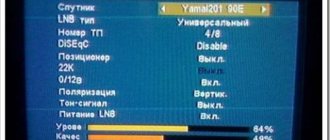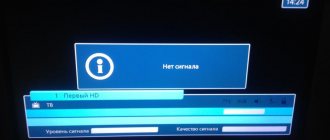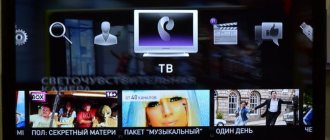From 2021, Russia will gradually switch from analogue to digital television. The first region where federal television channels have already completely switched to digital was the Tver region. This happened on December 3, 2021. In the Magadan region and Chechnya, as well as in the Penza, Ryazan, Tula, Yaroslavl and Ulyanovsk regions, analogue broadcasting was turned off on February 11.
After this, the transition to digital format will be gradual. In 20 subjects, including the Amur, Ivanovo, Kemerovo, Kirov, Kostroma, Kurgan, Lipetsk, Novgorod, Sakhalin, Tyumen regions, Moscow and the Moscow region, the Kabardino-Balkarian Republic, the Karachay-Cherkess Republic, the Republic of Kalmykia, the Republic of Mordovia, the Udmurt Republic , Chuvash Republic, Stavropol Territory and Yamalo-Nenets Autonomous Okrug, the transition to digital will occur on April 15. And on June 3, the remaining 57 Russian regions will switch to digital television.
How to set up your TV for digital TV without spending too much. Infographics Read more
Who will remain on analogue airwaves?
After the transition to digital television, Russians will be able to watch 20 channels of the first and second multiplexes (packages of channels whose signals are combined into a single digital stream) for free in good quality. These are Channel One, “Russia-1”, “Match TV”, NTV, “Petersburg - Channel 5”, “Russia - Culture”, “Russia-24”, “Carousel”, OTR, “TV”, “Spas”, STS , “Domashny”, “TV-3”, “Friday”, “Star”, “Mir”, “TNT”, “Muz-TV”.
Regional television channels and television channels that are not part of multiplexes, according to the general director of the Federal State Unitary Enterprise "Russian Television and Radio Broadcasting Network" (RTRS) Andrei Romanchenko , will continue analogue television broadcasting. At first - on one of the federal channels of the first multiplex. Most regional programs after the transition to digital will be available to viewers on the channels of the first multiplex (Russia-1, Russia-24 and Radio Russia). According to Deputy Head of the Ministry of Telecom and Mass Communications Alexey Volin , the analog format for regional channels will remain until 2021 and, at the request of TV channels, will be extended for subsequent periods.
Question answer
How do you know if your TV is receiving a digital signal?
Advantages of digital TV
Digital broadcasting allows you to transmit high-definition images (HDTV - 1 thousand 80 lines) with a frame rate of up to 60 per second. Supports transmission of widescreen video with an aspect ratio of 16:9.
Unlike analog TV, which requires a separate frequency for each of the over-the-air channels, over-the-air digital broadcasting combines several TV channels into one frequency - the so-called multiplex. This allows you to significantly increase the number of broadcast channels.
In addition, in some digital television networks, users can view program schedules on the TV screen, leave reviews, and in some cases, select films or broadcasts that interest them (video on demand).
There are different standards for digital television broadcasting. In most countries in Europe, Asia and Africa it develops according to the DVB standard. In Russia, the second generation DVB-T2 standard has been chosen for broadcasting.
What will happen to regional channels next?
In January 2021, members of the Federation Council made a proposal to include regional channels in the third multiplex. The draft recommendations of the Federation Council say that this could happen in 2020-2021, after funding sources are approved. Some senators believe that the state should finance the third multiplex. However, the Ministry of Telecom and Mass Communications does not agree with this. According to Alexey Volin, the use of federal funds for such a project is contrary to the requirements of the Budget Code; a third multiplex can appear in Russia only subject to regional funding.
So far, the department has recommended that local television switch to other broadcasting platforms, primarily cable television. A “21st button” law was even passed for 72 channels, which were exempt from cable distribution fees. According to the bill, in each subject, in accordance with the procedure established by the government, one mandatory public channel is selected, which will be assigned the 21st position on the television remote control. For example, in the Vologda region, such a channel became “Russian North”, in the Bryansk region - “Bryansk Gubernia”, in the Vladimir region - “Guberniya 33”, in the Voronezh region - “TV Guberniya”, in the Kaluga region - “NIKA-TV”, in the Kostroma region - “ TV channel "Rus", in Kurskaya - "Seim", in Tverskaya - "Tverskoy Prospekt - Region", in Tula - "First Tulsky", in Yaroslavskaya - "First Yaroslavsky", in Moscow - "Moscow 24", and in Moscow region - TV channel "Podmoskovye".
Timetable for the transition to digital TV in Russia
On November 15, 2021, the Russian government approved the proposals of the Ministry of Telecom and Mass Communications on the schedule for the transition to digital TV. The pilot shutdown of the analog signal began on December 3, 2021 in the Tver region.
On February 11, 2021, the analog signal was turned off in seven regions: Ryazan, Tula, Yaroslavl, Ulyanovsk, Penza and Magadan regions, as well as in the Chechen Republic. On April 15, 2019, the analog signal was turned off in 20 constituent entities of the Federation, including Moscow and the Moscow region. Initially, it was planned to complete the transition to digital broadcasting on June 3, but on May 13, it was decided to postpone the shutdown of the analog signal in 21 regions until October 14. As a result, on June 3, the transition was carried out in 36 regions.
Modern TVs that support the DVB or DVB-T2 standard can receive a digital television signal directly from a decimeter or all-wave antenna. Older TVs require a digital set-top box. Users subject to analog channel shutdown were alerted to the changes by the letter "A" on the screen. Low-income citizens at the municipal level received subsidies for the purchase of set-top boxes.
In large cities, in most apartment buildings, subscribers received digital cable television via a home antenna and until 2018, they did not feel any changes.
Search options
To manually configure digital TV, you need to know the search parameters for digital broadcasting channels.
The main parameters are:
- Frequency (starting frequency) 306000.
- Final frequency 354000.
- Symbol rate 7000.
- Modulation 128 QAM.
- Network ID Auto.
You need to find out the frequency of multiplexes separately for your region. The frequency differs for the two multiplexes and each region has its own. You can check the figure on the website. RU.
Where to go if you have questions?
A special federal line has been created for consultation. You can call her completely free: 8-800-220-20-02. There are also regional numbers for each region and region. Operators on these lines will answer all questions that will allow you to correctly set up digital television and switch to digital from cable broadcasting. You can also get basic advice and answers to the most common questions about how to switch your TV on the website Smotricitru.ru.
Cable television can have analogue or digital broadcasting. In most cases, cable providers make the switch to digital themselves, and users only need to set up their equipment. As for how to connect an old TV - if it is too old and does not have a built-in tuner that supports DTV-2 technology, then you will have to buy a set-top box. It is sold in all household appliances and electronics stores.
How to set up your TV yourself using the remote control to switch to digital?
After connecting, you need to correctly configure the multiplexes on the TV. This can be done in several ways. The general automatic configuration scheme is as follows:
- Connect the antenna wire to the “AIR/CABLE” connector.
- On the television remote control, press the “SOURCE” button and then select TV.
- Go to the TV menu.
- Find the “Broadcast” tab, then “Auto Setup” and press start.
- In the antenna tab, you need to select “Digital and analogue”.
Searching for all programs and then saving takes no more than 5 minutes. After this, you can safely enjoy broadcasting in a modern digital format.
Analog channels in Moscow
This section provides a list of analogue terrestrial channels. Let me remind you that analogue television broadcasting in Russia is planned to be switched off in 2018. In this regard, I believe that this section will be of little interest to anyone. Welcome to the new era - the era of digital terrestrial television!All meter and decimeter channels broadcast from the Ostankino TV tower, which allows them to be received even in the Moscow region. But the signals of decemeter channels are weaker than those of meter channels, which is why they can be received with some interference. Interference can be eliminated using amplifiers and signal processing circuits (rejectors, filters, attenuators, etc.); larger antennas; higher mast.
The quality of reception of terrestrial TV channels in the Moscow region depends on how close the signal repeater is.
Logo
| Channel number, range, frequency | Description |
| 01 Meter 149.75 | First channel . The basis of Channel One is information broadcasting. The channel's priorities: preservation and development of the traditions of educational, intellectual, cultural programs and programs related to entertainment broadcasting, including the most popular genre - film screening, as well as news, socio-political and analytical television. The basis of the structure of Channel One is information broadcasting. |
| 03 Meter 1 77.25 | TV Center. Began regular broadcasting in June 1997. Today, the potential audience of the channel is more than 60 million people. These are viewers from Russia, CIS countries and neighboring countries. More than 180 broadcast television companies and more than 100 cable television studios from all regions of the Russian Federation cooperate with TVC. The channel's broadcast schedule covers almost all television genres. These are informational, analytical, journalistic, artistic, educational, children's programs, talk shows and games, and, of course, films and TV series. |
| 06 Meter 2 175.25 | Sports . The Russian broadcast channel OTK Sport is part of the VGTRK holding. This specialized channel is addressed to a wide range of viewers. Its thematic and information programs are dedicated to various sports. Live broadcasts of sporting events occupy a significant place in the programs. |
| 08 Meter 2 191.25 | NTV . The NTV television company was created in 1993. At the moment, NTV is the only private Russian television channel that has federal status. The NTV audience in Russia exceeds 110 million people. In addition to the territory of Russia, NTV broadcasting extends to the CIS countries, as well as Western Europe, the Middle East, the USA and Canada. Every season the channel has new programs, films, TV series and entertainment projects. |
| 11 Meter 2 215.25 | Russia . In 1998, RTR became part of the unified production and technological complex of state media (VGTRK). The channel produces its exclusive news program “Vesti”, a large number of entertainment programs and feature films, is developing its own television projects, and broadcasts in Europe (the “RTR-Planeta” project). |
| 23 decimeter 487.25 | DTV. The only entertainment TV channel in Russia with a detective genre focus. “Detective on DTV” includes investigative films, detective series and even comedies. |
| 25 decimeter 503.25 | euronews. This is the leading European news channel, broadcasting around-the-clock chronicles of world events and commentary in seven languages: Russian, French, English, German, Italian, Spanish and Portuguese. The television company receives continuous streams of up-to-date video information from all over the world through the Eurovision exchange system, television news agencies, as well as from 18 television companies that share EuroNews. Unlike other European news programmes, EuroNews is not subject to political, religious or territorial pressure. And the independence of the TV channel ensures that viewers receive impartial information. |
| 27 decimeter 519.25 | STS . The first entertainment television. Over the 5 years of operation, the TV channel became the first profitable business project on the Russian media market. STS offers viewers programs of its own production, special projects and foreign entertainment programs. Now the channel works with 173 partners in 362 cities of Russia. |
| 29 decimeter 535.25 | Disney . On August 10, 2010, a long-awaited event happened - the Disney Channel began broadcasting in Russia! The channel broadcasts daily exciting programs for the whole family, including such popular animated and feature series as “Phineas and Ferb”, “Hannah Montana”, “Wizards of Waverly Place”, as well as feature-length films and Disney programs produced in Russia. |
| 31 decimeter 551.25 | Homemade . This is a family channel that is focused on useful programs that lead conversations about how to cope with everyday everyday problems, how to build and make a cozy home, how to take care of yourself and your children, and how to overcome illnesses. On the Domashny TV channel you can only see your favorite movies, and the channel’s film library is replenished with new film masterpieces every time. The channel airs a variety of TV shows, thematic programs about cooking, family, travel and animals. In its programs, the Domashny TV channel conveys positive emotions, gives useful advice to all family members, which retains a huge audience and attracts new viewers. The TV channel is broadcast in Russian. |
| 33 decimeter 567.25 | Culture . Cultural and educational programs, documentaries, children's and art programs, broadcasts from concert halls, theaters, museums. On-air channel in digital version "NTV Plus". |
| 35 decimeter 583.25 | TNT . This is a television channel that is the largest television network in Russia. In terms of coverage area, the TNT channel is in no way inferior to the central Russian television channels. According to some data, TNT's viewership reached about 100 million people already at the beginning of 2008. The TV channel cooperates with more than 500 partners throughout Russia. |
| 38 decimeter 607.25 | Friday - this is a premonition of a holiday and a first-class vacation! And the TV channel FRIDAY! – this is the joy that has already come from a great mood and good news any day of the week! To escape from serious everyday life, you no longer have to wait for Friday, because FRIDAY! already with you! Funny and charming heroes of the brightest TV series and world cinema hits, crazy love passions of the most exciting reality shows, the most precious bars of the entertainment TV gold fund, as well as a wide variety of programs about everything in the world - from cuisine, fashion and health to adventure, mysticism and sports ! This is FRIDAY! Every day - on your TV! TV channel FRIDAY! We are canceling weekdays! |
| 40 decimeter 623.25 | St. Petersburg Channel Five. “Television Internet” is the concept of this channel. Real life television - live broadcasts, live conversations in the studio, heated discussions on modern topics, different points of view on what is happening in the country - “uncut.” Up to nine newscasts a day, with a strong focus on regional issues. TRC "Petersburg - Channel Five" offers new films for film lovers, documentary broadcasts, educational programs, health programs, a television dating service and much more. And most importantly, this is interactive, “live” television. |
| 46 decimeter 671.25 | TV 3 . Fantasy, mysticism, adventure. This is a Russian channel broadcasting Russian and foreign feature films. The TV3 channel is a software product for various audiences. |
| 49 decimeter 695.25 | REN TV . One of the largest private federal channels in Russia. The REN TV channel began broadcasting on January 1, 1997. It is positioned as universal. The broadcast schedule includes domestic and foreign films, information programs, entertainment programs and music, sports, documentaries, and cult “A” class series. REN TV has created its own animation and special effects studio, which produces REN TV's signature original product (know-how) - the famous virtual programs. The channel has created the film association “REN-Film”, which has released more than two dozen films and TV series. |
| 51 decimeter 711.25 | Channel "Yu" is the only TV channel for girls. There is no politics, football or biathlon here, there is no crime or cruelty. “Yu” stands for love, beauty, fashion, sincerity, self-improvement and compliments. |
| 57 decimeter 759.25 | Star . The main audience of the channel are men with above-average income and aged 46 years. The TV channel broadcasts programs in support of existing government institutions, in defense of Russia's national interests and cultural priorities, the consolidation of society, and the restoration of the authority of the Russian army. Today, the channel's 24-hour broadcast is a high-quality artistic screening of foreign and domestic documentaries, original programs, talk shows, popular science, journalistic and children's programs. |
| 60 decimeter 783.25 | 2×2. It is an analogue of the American channel Adult Swim, that is, it broadcasts only cartoons and animated series translated or dubbed into Russian. Some of them have already been shown on other Russian channels and were re-shown by the “2×2” channel, such as “The Simpsons”, “Futurama” and “Family Guy” (Ren-TV) or “Stripirella”, “South Park” (MTV Russia). A distinctive feature of the channel is also the broadcast of popular domestic (Soviet) cartoons, often taking place during prime time. The channel has also started airing some famous anime series. |
| MMDS | Moscow 24 . The main task of the channel is to provide Muscovites with operational information around the clock, so news forms the basis of the broadcast network. News releases are published every 30 minutes as part of the Megapolis program. They also show programs for young people, entertainment programs and films dedicated to the capital. |
Tags:
- channels in Russian
- terrestrial TV
What to do if your TV does not support digital format
If your TV does not support this format, you need to purchase additional equipment - a digital set-top box (receiver). If you have two TVs that you watch through an antenna, and you want to watch different channels on them, you need to purchase a set-top box for each of them. The digital set-top box needs to be connected to the TV and configured:
- Step 1: Turn off the TV's power.
- Step 2. Connect the antenna cable to the antenna input of the digital set-top box. Connect the video and audio cables to the appropriate jacks on your TV and set-top box. The image quality will be higher when connecting the set-top box to the TV with an HDMI cable.
- Step 3: Connect the power and turn on the TV.
- Step 4. From the menu, select the required input source: HDMI, AV, SCART and others.
- Step 5. Automatically search for digital TV programs using the operating instructions. You can perform a manual search. In this case, you must enter the channel number or frequency.
How to receive monetary compensation
It should be noted that not all TV models can receive a digital signal. After analog TV is switched off in the regions, subscribers using equipment that supports the DVB-T2 broadcasting standard will be able to tune in free channels. These are mainly TVs produced after 2013.
What should owners of old TVs do? An alternative to purchasing new equipment is to use a digital receiver. After switching off analogue television in Russia, subscribers will be able to count on compensation for funds spent on the purchase of new equipment.
Only those citizens of the Russian Federation whose wages are below the subsistence level will be able to participate in the state support program. This indicator varies significantly depending on which region we are talking about. For example, the cost of living in St. Petersburg is 11,000 rubles, and in the capital of Russia – 16,200 rubles.
Low-income families will also be able to receive compensation. This status is secured only if each family member earns less than the subsistence level. The amount of monetary compensation varies in the range of 1000-6000 rubles.
The maximum monetary compensation will be received by Russian citizens who live in settlements not included in the coverage area of the terrestrial digital TV network. Almost all regions of the country have such settlements. The corresponding list can be found on the websites of regional MFCs.
Compensation is provided for the purchase of a digital tuner, UHF TV antenna or TV with DVB-T2 support. It is mandatory to keep the purchase receipt. Contact the MFC, having previously written an application for a refund of the money spent. Indicate the bank details to which the funds will be transferred. In addition to checks, you must attach copies of passports and income certificates for the 1st quarter of all family members to your application. Please also provide your registration information. After reviewing the application, the money will be credited to your account.
How to understand what type of broadcasting is on your TV?
- Before switching and changing anything, the user must understand what kind of TV he has and whether his TV is capable of supporting the digital format.
If there is a letter “A” next to the logo of the broadcast program, it means the TV is analogue. To understand whether a TV supports digital broadcasting, you need to focus on the year of manufacture and technical specifications. Modern models released after 2014 have built-in digital tuners. Such TVs all support digital and only require auto-tuning of channels to find all possible broadcasts. - There is another way to find out. In the instructions in the characteristics opposite the DTV-2 format, there should be o. This means that the TV has a tuner that allows you to receive digital signals. In other cases, you will have to additionally purchase and connect a specialized set-top box to the TV.
- You can also find a list of TV models on the Internet that support this technology.
If there is a cable TV in the apartment, will it be necessary to convert it to digital?
The main advantages of cable television:
- There is no need to buy additional devices.
- Large volume of broadcast channels.
- Individual selection of channels that the user wants to watch.
- There is no need to purchase an antenna amplifier and power supply for it.
But cable TV also has its disadvantages:
- Much depends on the provider.
- Quality is considered lower, especially in remote areas.
Compared to cable TV, digital has many more advantages. 10 channels are broadcast at once on one frequency, this makes it possible even in remote villages, after connecting, to view 20 channels, instead of the usual three. The disadvantages include that you will need a decimeter antenna. If the user wants to keep analog TV, he will have to purchase an all-wave antenna.
Following the latest changes, most cable TV providers are gradually switching to a modern broadcast format. Therefore, for many subscribers nothing will change; they will only need to set up digital reception on their TV.
If you have cable TV, you will have to switch to digital to watch the main 20 channels.
At the same time, you can continue to watch other channels on cable TV. If the cable provider independently switched to a new mode, then in this case all the user’s channels will be digital.
Joining RTRS
Operators actively used over-the-air antennas to receive signals from local channels when relaying them to the network, especially when it came to small segments of the network, the connection of which to a single structure was not financially feasible. The situation changed after so-called points of accession to RTRS appeared on the agenda. From this moment on, cable operators have the right to take the signal of 20 free channels (and the 21st regional one - cable “21 Buttons”) not from the air, but only from a source agreed with RTRS in the network’s service territory, paying for the connection project and monthly line maintenance. Naturally, even after the service areas of cable operators were clarified, not everyone found it profitable to run fiber to the local RTRS branch. The funniest situation looked exactly in the service area of the operator mentioned above - for its 772 collective antennas, not connected into a single network, RTRS issued approval for connection, despite any explanations.
Subsequently, the operator sorted out this contradiction, but only after changing the license. In principle, he has not yet renounced the license, although the operation and maintenance of the system for collective reception of a digital signal has been recognized as economic activity that does not require licensing. However, this raised more questions than answers.
How to connect both broadcast standards to one TV?
If you need to connect cable and terrestrial TV to one TV at once, then this will not be difficult. First you need to combine the two cables into one. To do this you will need to purchase a splitter. Both types of TV are connected to it, and the output is general broadcasting.
Be sure to clarify the frequency range in which cable and digital TV is broadcast. In some regions they may overlap each other, but in others they may not coincide at all. If the frequencies match, some channels may not show well. In this case, you need to buy a notch filter that will suppress the cable TV signal and let digital through. In this case, the frequencies will not mix.
Not without difficulties
“There will be no subscription fee”
Deputy Head of the Ministry of Telecom and Mass Communications Alexey Volin - about the reduction of analogue television broadcasting, the fight against pirates and “death groups” in social networks
1.2 million households may be left without TV during the transition to digital broadcasting, said the head of the Ministry of Telecom and Mass Communications, Konstantin Noskov, on December 11 during a government hour in the Federation Council. The representative of the Cabinet of Ministers assured that everything will be fine - volunteers will help install the consoles, and they will cost from 700 rubles. Ensuring that networks do not take advantage of the hype is the task of the Federal Antimonopoly Service (FAS).
The FAS warned back in October that the transition to digital TV would not be smooth sailing. “If operators are ready to provide a service, but the population is not ready for technical, economic and other reasons, then this can create tension - accordingly, both in the markets and in society,” emphasized deputy head of the department Anatoly Golomolzin. At the same time, he admitted that a transition is needed - this way Russians will receive free TV channels in the highest quality, which is now only provided by a paid package.
console
Set-top box for receiving digital television signal
Photo: RIA Novosti/Evgeniy Biyatov
FAS opened a case due to rising prices for digital TV set-top boxes
Stores have already taken advantage of the excitement. FAS began proceedings due to an increase in prices for digital TV set-top boxes. Electronics chains Eldorado, M.Video and Yulmart were also caught artificially inflating prices. An administrative case was opened against them.
“In the low price segment, price increases range from 30% to 100%. In the segment over 1 thousand rubles, the increase ranges from 5% to 83.9%,” the FAS clarified. However, the networks denied all accusations. The Association of Retail Trade Companies states that stores, on the contrary, quickly sent an additional batch to the Tver region at a price of less than a thousand rubles. And the excitement itself, AKORT is confident, arose due to shortcomings of executive authorities in terms of informing the population.











